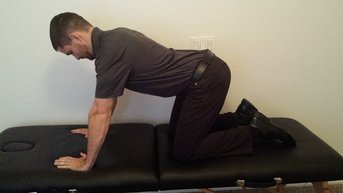- Home
- About Us
- TSPT Academy
- Online Courses
-
Resources
- Newsletter
- Business Minded Sports Physio Podcast
- Day in the Life of a Sports PT
- Residency Corner
-
Special Tests
>
-
Cervical Spine
>
- Alar Ligament Test
- Bakody's Sign
- Cervical Distraction Test
- Cervical Rotation Lateral Flexion Test
- Craniocervical Flexion Test (CCFT)
- Deep Neck Flexor Endurance Test
- Posterior-Anterior Segmental Mobility
- Segmental Mobility
- Sharp-Purser Test
- Spurling's Maneuver
- Transverse Ligament Test
- ULNT - Median
- ULNT - Radial
- ULNT - Ulnar
- Vertebral Artery Test
- Thoracic Spine >
-
Lumbar Spine/Sacroiliac Joint
>
- Active Sit-Up Test
- Alternate Gillet Test
- Crossed Straight Leg Raise Test
- Extensor Endurance Test
- FABER Test
- Fortin's Sign
- Gaenslen Test
- Gillet Test
- Gower's Sign
- Lumbar Quadrant Test
- POSH Test
- Posteroanterior Mobility
- Prone Knee Bend Test
- Prone Instability Test
- Resisted Abduction Test
- Sacral Clearing Test
- Seated Forward Flexion Test
- SIJ Compression/Distraction Test
- Slump Test
- Sphinx Test
- Spine Rotators & Multifidus Test
- Squish Test
- Standing Forward Flexion Test
- Straight Leg Raise Test
- Supine to Long Sit Test
-
Shoulder
>
- Active Compression Test
- Anterior Apprehension
- Biceps Load Test II
- Drop Arm Sign
- External Rotation Lag Sign
- Hawkins-Kennedy Impingement Sign
- Horizontal Adduction Test
- Internal Rotation Lag Sign
- Jobe Test
- Ludington's Test
- Neer Test
- Painful Arc Sign
- Pronated Load Test
- Resisted Supination External Rotation Test
- Speed's Test
- Posterior Apprehension
- Sulcus Sign
- Thoracic Outlet Tests >
- Yergason's Test
- Elbow >
- Wrist/Hand >
- Hip >
- Knee >
- Foot/Ankle >
-
Cervical Spine
>
- I want Financial Freedom
- I want Professional Growth
- I want Clinical Mastery
|
One treatment technique that physical therapists are most known for is exercise. There are many, many different exercises out there, and we are limited only by our own creativity. Unfortunately, is is far too easy for us to fall into the habit of prescribing an exercise based on diagnosis or what we think are patterns of presentation. In reality, our exercise prescription should only be based on impairment and potential co-morbidities and biopsychosocial factors. The most obvious component to consider is the impairment. We typically give an exercise to address deficits in strength, mobility, motor control or the cardiovascular system. If a muscle is weak, we try to strengthen it. If a straight leg raise is limited by neural tension, muscle flexibility, etc., we address it. If there is a potential abnormal movement pattern, we may try to fix it. As far as the CV system goes, this often has to be challenged in patients with chronic pain in particular, but applies to many different types of injuries. Included in these, of course, is proper dosage. Far too much do I see patients performing the majority of their exercises on the table. While plenty can be done to progress a patient there, we must be certain we are appropriately challenging them. Almost no one functions completely supine, so getting to the upright and dynamic position is critical. Also, we shouldn't just blindly give an exercises 3 reps of 10. An exercise targeting strength-building should be about 6 repetitions where the weight is so heavy that another repetition is not possible. Rest between sets plays a role as well for which metabolic system is being challenged. Make certain your dosage addresses what you want (strength, tissue loading, whatever). I often say to my patients if they aren't sweating, I'm not doing my job. Addressing the impairment is actually the easy part. Making sure you consider the impact of any co-morbidities or any biopsychosocial factors is probably more important, but definitely more difficult, in my opinion. A patient s/p TKA may be ready to move off the table, but their history of a neurological issue impairing their balance may make you concerned. This is where you have to get creative in progressing your patient, while ensuring the appropriate precautions. Regarding the biopsychosocial factors, fear-avoidant behavior is one of many things we will encounter. There are plenty of patients that have a mental component that needs to be addressed in order to help them improve their function. While a big focus should definitely be on pain science, that isn't wear it stops. Sometimes we have to introduce motion in a less threatening manner in build from there. Sometimes we have to work out the cardiovascular system as discussed previously. These are essential for consideration as simply addressing the impairment doesn't always work. Exercise selection is fundamental for physical therapists and should have quite a bit of thought go into the process. I challenge you to assess what each exercise is supposed to be doing and is it actually doing it with each patient you see tomorrow. Odds are you will start to makes some change and then notice your patients making changes as well. -Dr. Chris Fox, PT, DPT, OCS
0 Comments
Leave a Reply. |
Dr. Brian Schwabe's NEW Book in partner with PaleoHacks!
Learn residency-level content on our
Insider Access pages We value quality PT education & CEU's. Click the MedBridge logo below for TSPT savings!Archives
July 2019
Categories
All
|









 RSS Feed
RSS Feed